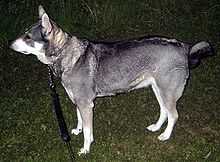Jämthund
 | ||||||||||
| A photo of a Jämthund | ||||||||||
| Other names | Swedish Elkhound | |||||||||
|---|---|---|---|---|---|---|---|---|---|---|
| Country of origin | Sweden | |||||||||
| ||||||||||
| ||||||||||
| Dog (Canis lupus familiaris) | ||||||||||
The Jämthund, also called the Swedish Elkhound/Moosehound, is a breed of dog of the Spitz type that are found in Northern Europe. The Jämthund is eponymous to Jämtland, a province in the middle of Sweden. The dog is described as having a wolf-like appearance.
Appearance
The dog has a loosely curled tail which should hang on the back, tightly curled or thin looking is a serious fault, when relaxed the tail drops down to a straight shape. It has erect ears with wide space in between them; medium to long muzzle; strong, long endurance; and has a double coat of many various shades of agouti. The eyes are brown. The size of the male is usually between 57 and 65 centimetres (roughly 22 to 26 inches), weighing 30 to 35 kilograms (66 to 77 pounds). Females are usually between 52 to 60 centimetres (20 to 24 inches), weighing 25 to 30 kilograms (55 to 66 pounds). There is a big difference between the Jämthund and Norwegian grey elkhound, the Norwegian elkhound is a lot shorter, stockier and has a black mask on the muzzle, while the Jämthund has a white muzzle, white cheeks and typical wolf markings, it is taller, longer and the tail shape is far more different than the Norwegian.
Temperament
Although calm and affectionate with its family, the Swedish Elkhound can be dominant with other dogs and has a strong prey drive. A truly all-around canine, it can go from a hunting trip and back to the family hearth with great aplomb. It takes things in stride and does not get ruffled easily, making it a steady partner in the field or at home.
The Swedish Elkhound is a happy learner who loves to please its owner.
Exercise
As with most breeds developed for hunting, the Swedish Elkhound requires a lot of regular exercise to stay fit, both physically and mentally. It quickly becomes bored if kept indoors for too long and can become destructive.
Grooming
Regular brushing is necessary to keep the dense undercoat from matting. Bathing should not be done too often because it tends to dry out the weather-resistant coat.
History
The Jämthund received official recognition as a breed in 1946, due to intensive work by Aksel Lindström and others. Before that, the Jämthund and the Norwegian Elkhound were seen as the same breed.
Despite this short history of official breed recognition, it is often claimed that Jämthunds have been raised by the locals in Jämtland since the end of the last ice age.[citation needed] They are used for moose hunting and sled pulling. In the local dialect, it used to be referred to as bear dog. It is one of very few dogs that will not back off from a bear.
References
| Wikimedia Commons has media related to Jämthund. |
- Klütsch CFC, Seppälä EH, Lohi H, Fall T, Hedhammar Å, Uhlén M, Savolainen P (2010) Regional occurrence, high frequency but low diversity of mitochondrial DNA haplogroup d1 suggests a recent dog-wolf hybridization in Scandinavia. Animal Genetics, online early.
| |||||||